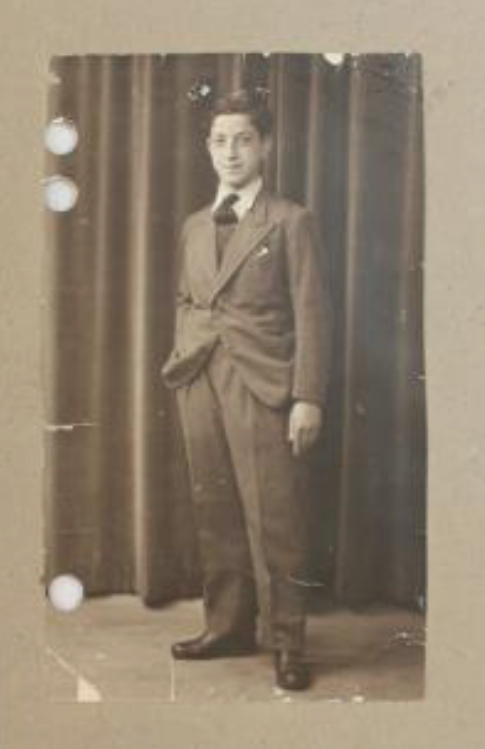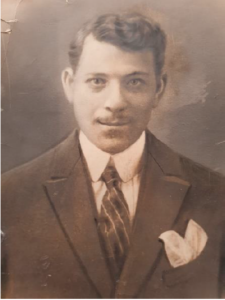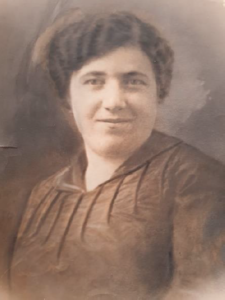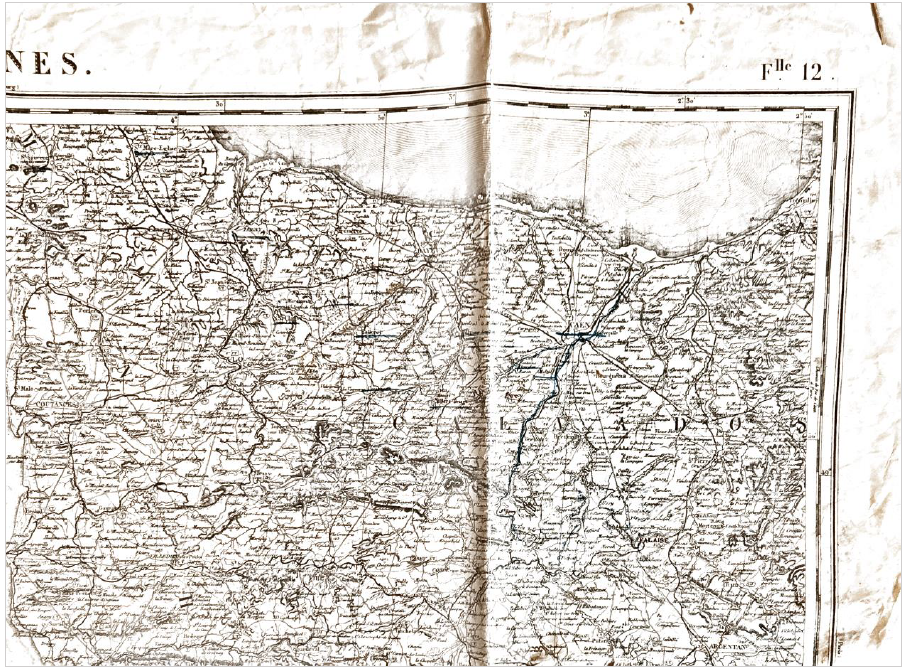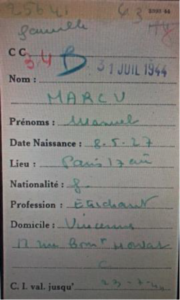Manuel MARCU
The biography that you are about to read was written by Marième Babou, Victorine Lecoconnier, Sacha Mellul, Rebecca Mokoko, Norma Roux-Mireux, Louna Sanchez, Matthieu Chanay and Joaquim Ramos, 9th grade students at the La Cerisaie middle school in Charenton-le-Pont, in the Val-de-Marne department of France, with the guidance of Nathalie Baron and Sonia Drapier, their History and Geography teachers. It was written during the 2023-2024 school year.
We were lucky enough to track down Jean-Pierre Fayer, Elisa Marcu’s son, via the Internet. We would like to thank both him and his family for all their help with our research, for providing us with various records and for coming to our school to meet us. We would also like to thank Jacques Gragnon and Philippe Roza, who also contributed to our research. We are happy to be able to share Manuel’s biography with you here. Meanwhile, some of our fellow students have written the biographies of his father, Ilie, and his sister Elisa, and these too can be found on the Convoy 77 website.
Our research was based on records from the Val de Marne Departmental archives, the French Historical Defense Service Memorial in Caen in the Normandy department of France, the Shoah Memorial in Paris, the Paris Police Headquarters and the Arolsen Archives.
I- A war-torn childhood
Manuel Marcu was born on May 8, 1927 in the 17th district of Paris. His parents, Ilie Marcu and Blanche Leibovici, were originally from Romania but were naturalized French citizens. Ilie moved to France in 1913 and Blanche arrived soon afterwards. HIs paternal grandparents, Leid and Itie Hers-sin Marcu, stayed behind in Negresti in Romania, while his maternal grandmother, Sara Leibovici lived in Codăești.
Ilie and Blanche Marcu – date unknown
Source: Marcu-Fayer family
Manuel had two brothers, Isaac, who was born on 10 February 1915 and Jean, born on September 12, 1918, and a sister, Élisa, born on March 8, 1921. All four children were born in Paris.
According to Ilie and Blanche’s marriage certificate, the Marcu family initially lived at 3 rue de Puteaux, in the 17th district of Paris. They then moved to 12 rue du commandant Mowat in Vincennes in the early 1930s. Ilie had been renting premises for his shoemaking business at 4 place Bérault in Vincennes since 1926, while Blanche did not work outside the home.
Manuel was 12 years old when his mother died as a result of diabetes on June 22, 1939 in the 12th district of Paris.
Extract from the 1936 census of Vincennes
Source: Val de Marne departmental archives
According to Elisa’s son, Jean-Pierre Fayer, whom we met, Manuel went to nursery school on rue des Dames in Paris and then to the Est elementary school in Vincennes. We found his name in the register, which shows that was enrolled there on January 30, 1934. He was 7 years old at the time, so this might have been when the family moved to Vincennes. According to the register, Manuel was “A fairly good pupil. Hard-working. Well behaved”. He stayed on for classes at a higher level, but we do not know where he continued his education after that.
In his book on Victor Gragnon, Georges Sentis quotes his recollections of the times when Elisa spoke to him about her family:
“She loved to talk to me about her family (…) She adored her younger brother. After declining several times, I agreed to meet him after school. She was so happy to introduce me to her brilliant student brother, a tall, shy boy”.
Extract from the register of the Est elementary school in Vincennes
Source: Val de Marne departmental archives
Manuel grew up in a family of communists and resistance fighters.
His father, Ilie, was an activist in Romania before he joined the French Communist Party. During our research, we came across a document in the Paris Police Headquarters archives relating to a search of the family apartment and Ilie’s shoemaking business that took place at 3 p.m. on June 26, 1940. The report states that no weapons were found, but that various documents were seized. These included a French Communist Party membership card from 1937, a card for the French – Soviet association in Paris dated 1938, two postcards addressed to Isaac that included communist slogans, two letters addressed to Jean about communist issues, and a notebook featuring a hammer and sickle.
Jean-Pierre Fayer, Elisa Marcu’s son, told us that his mother was a member of the women’s communist movement “Les femmes françaises”. There is more detail about this in Elisa’s biography.
Even though he was still quite young, we suppose that Manuel would have been involved in some of the family’s political discussions.
Jean-Pierre Fayer also sent us a map that Manuel, then aged 17, probably made, showing the progress of Anglo-American troops following the Normandy landings on June 6, 1944. The family followed the news of the liberation eagerly, unaware that some of them would no longer be there to witness it.
Manuel’s map showing the Allies’ progress
Source: Marcu-Fayer family
II- The arrest
The prospect of imminent liberation may well have contributed to the Marcu family letting their guard down. In July 1944, although it was still risky, the family unwisely arranged to meet up at their house in the Courdreaux district of Courtry, in what is now the Seine et Marne department.
The following photo was almost certainly taken while they were there. It shows Elisa, Blanche, Jean and Manuel, flanked by two cousins, Maurice on the left and Henri on the right.
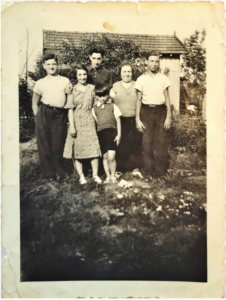
Family photo – date unknown
Source: Marcu-Fayer family
In a letter, held at the Shoah Memorial, Elisa wrote: “On the orders of the party, I left my family. But I was very fond of my family. One Sunday in July 1944 (I think it was the 24th), I went out into the countryside with my brother, who was only 17. We were reported by a neighbor. That day, 17 of us were arrested”.
Jean-Pierre Fayer told us that the Marcu family had been reported by a neighbor, a “white” Russian refugee in France. According to the records, Ilie, Elisa and Manuel were actually arrested on Sunday July 23, 1944, along with 17 other people who were not members of the family. One record also names Aldolphe Leibovici and his wife, who may have been Blanche’s brother and sister-in-law.
The whole neighborhood witnessed the arrest, including a Mr. or Mrs. Leclerc and Mrs. Lebord, according to Elisa’s file in the Caen Memorial Archives, as did the Mayor of Courtry, according to Ilie’s file. We have been unable to trace any of them.
While they were all on a bus on their way to Drancy camp, Jean-Pierre Fayer told us that Elisa’s father, Ilie, threw a short, handwritten message out of the window, which he wanted to be forwarded. The note was addressed to a Mr. Pagès, who lived at 2 place Bérault in Vincennes. Jean-Pierre still has this handwritten note, a sad reminder of what happened to his family.
Ilie’s handwritten note
Source: Marcu-Fayer family
III- The deportation
Manuel arrived at the Drancy internment camp, together with Ilie and Elisa, on July 23, 1944.
His Drancy camp admission card says that he was a student.
The letter B on the record card below signifies that he was subject to immediate deportation. He was initially interned in room 4 on staircase 3, in the same room as Elisa and Ilie. However, Ilie and Manuel were then moved to room 3 on staircase 4, while Elisa was moved to room 2.
After having been interned in Drancy, Manuel, along with 1305 other prisoners, was deported to Auschwitz on Convoy 77 on July 31, 1944. The convoy left Drancy, travelled through northern France and Germany and finally arrived at the Auschwitz concentration camp in Poland.
Manuel was one of the 324 children under 18 who were deported on the convoy, which left France just 17 days before Drancy camp was liberated.
Manuel’s internment card from Drancy camp
Source: Shoah Memorial, Paris
The journey to the Auschwitz-Birkenau camp took 3 days and 3 nights. Living conditions on the journey were appalling, with up to a hundred people crammed into locked cattle cars. As soon as they arrived, on the night of August 2 to 3, a huge selection took place, separating those who were deemed fit to work from those who were not. 291 men were held in the camp and tattooed with the numbers B-3673 through B-3963, while 183 women were assigned the numbers A-16652 through A-16834.
Most of the deportees were murdered in the gas chambers as soon as they arrived, including all the children.
Manuel survived the selection and was taken into the camp, but we have no details of what happened to him there, what his tattoo number was, what work he did.
In the records we obtained from the Arolsen Archives, Manuel’s name is listed in files documenting his internment in the Natzweiler concentration camp, where he was assigned the number 43200.
Natzweiler concentration camp internee register
Source: Arolsen archives
Manuel was subsequently sent to the Vaihingen (Wiesengrund) hospital camp, but we do not know why, or when. The camp registers list Manuel as having died on February 4, 1945 at 3:15 p.m.
Registre des décès du camp de concentration de Vaihingen
Source : Arolsen archives
Vaihingen concentration camp death register
Source: Arolsen archives
During our research, we came across an article in the French newspaper Le Figaro that suggested a possible reason for Manuel having been sent to Vaihingen and dying there.
Extract from an article published in Le Figaro on January 27, 2015:
“On April 7, 1945, the French army came upon the Vaihingen camp in Germany, an annex of the Natzweiler-Struthof camp in Alsace. Opened in August 1944 and near Stuttgart, the camp housed workers – Jewish prisoners from Auschwitz – who were used to construct an underground weapons factory on what was known as the “Stoffel” worksite. The work was soon discontinued, and the camp converted into an “SS camp for the sick and convalescent”. From October onwards, convoys of invalids transferred from the Natzweiler annex camps were added to the prisoners already there who were unfit for work. Left to fend for themselves, the sick prisoners lived in appalling conditions, in unheated accommodation, with no medical treatment and insufficient food. Epidemics of typhus, tuberculosis and dysentery wrought havoc on their exhausted bodies.”
Records from the Arolsen Archives show that Manuel was buried in the Ensingen cemetery (in honor of Vaihingen internees), as his name is on the list of bodies exhumed in 1958.


 Français
Français Polski
Polski